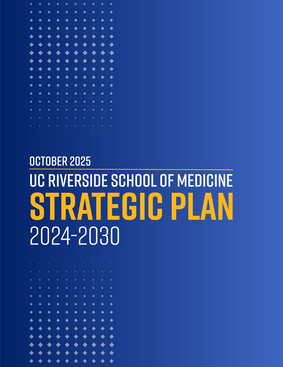
School of Medicine Strategic Plan 2024-30
Message from Vice Chancellor and Dean Deborah Deas
October 2025
Dear colleagues,
I am incredibly excited to announce our updated UC Riverside School of Medicine Strategic Plan 2024-2030. This strategic plan, along with our mission areas and our values, are the foundation of the School of Medicine. They provide the vision and foundation that drive our activities in pursuit of fulfilling our mission to train a diverse physician, public health, and biomedical scientist workforce and develop research and clinical care to serve the population of the Inland Southern California region. As the School of Medicine builds on the progress of previous years and advances our strategic plan, I would like to highlight several key milestones:
- UCR Health is executing a 10-year, multi-phase expansion plan, formally announced at a ceremonial signing in June. This initiative will strengthen our ability to meet the healthcare needs of the Inland Empire by expanding access to primary and specialty care, while also creating opportunities to train more students and support the growth of medical school enrollment.
- In 2025 the SOM graduated our ninth cohort of medical students, who proudly achieved a 99% residency training placement rate with 76% remaining in Southern California for residency training.
- In early September, the inaugural cohort of students in the UCR School of Medicine's Master of Public Health program started their two-year journey towards their degree. Of these students, 80% are residents of Inland Southern California, 40% are graduates of UCR and 67% are first generation college students.
- Under the leadership of Michelle Anne Bholat MD, MPH, chair of the Department of Family Medicine, the UCR School of Medicine welcomed a new cohort of eight residents into the relaunched Family Medicine Residency Program hosted at Dignity Health’s San Bernardino Medical Center.
We will continue to build on these accomplishments and look forward to working closely with all of you to successfully execute the initiatives outlined in this plan.
Sincerely,
Deborah Deas, MD, MPH
Vice Chancellor of Health Affairs
Mark and Pam Rubin Dean
University of California, Riverside School of Medicine
Imperatives and Strategies
| IMPERATIVE #1 | IMPERATIVE #2 | IMPERATIVE #3 | IMPERATIVE #4 | IMPERATIVE #5 |
|---|---|---|---|---|
| Standardize and modestly grow education programs. | Strengthen UCR Health and position it for long term system development. | Deepen commitment to clinical and population health research and integration within SOM and with other schools and colleges at UCR. | Build and strengthen strategic philanthropy that supports all aspects of the UCR SOM mission. | Improve UCR SOM processes, operations, and employee engagement. |
| Strategy #1 Recruit mission-aligned students to serve Inland Southern California. |
Strategy #1 Improve baseline operational performance and support structures aligned with industry standards.*** |
Strategy #1 Build the UCR SOM clinical departments’ and divisions’ capacity to conduct clinical research. |
Strategy #1 Build capacity and expertise of the Development Office to pursue greater funding opportunities reaching $7M per year. |
Strategy #1 Provide responsive work environments that maximize employee productivity and engagement. |
| Strategy #2 Strengthen and grow GME programs with existing partner hospitals and establish new programs. Expand focus on recruiting mission-fit trainees. |
Strategy #2 Increase UCR Health revenue stream from new programs and services.* |
Strategy #2 Leverage the Centers of the UCR SOM to develop translational and clinical research opportunities. |
Strategy #2 Modestly work toward implementation of alumni engagement plan and evaluation opportunities for business development and industry collaborations.* |
Strategy #2 Institutionalize the evaluation process for employees of the SOM. |
| Strategy #3 Continue to implement program evaluation and continuous improvement processes to improve and integrate learning strategies/technologies into the student and trainee experience. |
Strategy #3 Develop infrastructure for improved operations.*** |
Strategy #3 Increase and better assess the impact of UCR SOM research activities within its extensive network of organizations. |
Strategy #3 Align Development activities to specifically fund mission-focused programming of the UCR SOM. |
Strategy #3 Establish and promote community building within the School of Medicine. |
| Strategy #4 Develop and integrate new degree programs. |
Strategy #4 Build on current patient safety and clinical quality programs.* |
|||
| Strategy #5 Develop the long-term strategy and plan for UCR Health. |
||||
| IMPERATIVE #6 — Develop a strategic plan to advance diversity, equity, and inclusion. | ||||
| * Indicates edited strategy | ||||
